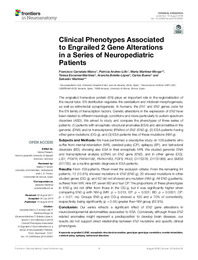Resumen :
The engrailed homeobox protein (EN) plays an important role in the regionalization of the neural tube. EN distribution regulates the cerebellum and midbrain morphogenesis, as well as retinotectal synaptogenesis. In humans, the EN1 and EN2 genes code for the EN family of transcription factors. Genetic alterations in the expression of EN2 have been related to different neurologic conditions and more particularly to autism spectrum disorders (ASD). We aimed to study and compare the phenotypes of three series of patients: (1) patients with encephalic structural anomalies (ESA) and abnormalities in the genomic (DNA) and/or transcriptomic (RNAm) of EN2 (EN2-g), (2) ESA patients having other gene mutations (OG-g), and (3) ESA patients free of these mutations (NM-g). Subjects and Methods: We have performed a descriptive study on 109 patients who suffer from mental retardation (MR), cerebral palsy (CP), epilepsy (EP), and behavioral disorders (BD), showing also ESA in their encephalic MRI. We studied genomic DNA and transcriptional analysis (cDNA) on EN2 gene (EN2), and in other genes (OG): LIS1, PTAFR, PAFAH1B2, PAFAH1B3, FGF8, PAX2, D17S379, D17S1866, and SMG6 (D17S5), as a routine genetic diagnosis in ESA patients. Results: From 109 patients, fifteen meet the exclusion criteria. From the remaining 94 patients, 12 (12.8%) showed mutations in EN2 (EN2-g), 20 showed mutations in other studied genes (OG-g), and 62 did not showed any mutation (NM-g). All EN2-g patients, suffered from MR, nine EP, seven BD and four CP. The proportions of these phenotypes in EN2-g did not differ from those in the OG-g, but it was significantly higher when comparing EN2-g with NM-g (MR: p = 0.013; EP: p = 0.001; BD: p = 0.0001; CP: p = 0.07, ns). Groups EN2-g and OG-g showed a 100 and a 70% of comorbidity, respectively, being significantly (p = 0.04) greater than NM-group (62.9%). Conclusion: Our series reflects a significant effect of EN2 gene alterations in neurodevelopmental abnormalities associated to ESA. Conversely, although these EN2 related anomalies might represent a predisposition to develop brain diseases, our results did not support direct relationship between EN2 mutations and specific clinical phenotypes.
|

 La licencia se describe como: Atribución-NonComercial-NoDerivada 4.0 Internacional.
La licencia se describe como: Atribución-NonComercial-NoDerivada 4.0 Internacional.
.png)